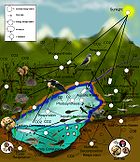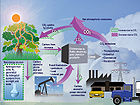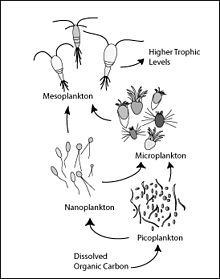- Microbial loop
-
The microbial loop describes a trophic pathway in the marine microbial food web where dissolved organic carbon (DOC) is returned to higher trophic levels via the incorporation into bacterial biomass, and coupled with the classic food chain formed by phytoplankton-zooplankton-nekton. The term microbial loop was coined by Azam et al. (Fenchel 2008) to include the role of marine bacteria playing in the marine ecosystem carbon and nutrient cycles in the marine environment. In general, dissolved organic carbon (DOC) is introduced into the ocean environment from bacterial lysis, the leakage or exudation of fixed carbon from phytoplankton (e.g., mucilaginous exopolymer from diatoms), sudden cell senescence, sloppy feeding by zooplankton, the excretion of waste products by aquatic animals, or the breakdown or dissolution of organic particles from terrestrial plants and soils (Van den Meersche et al. 2004). Bacteria in the microbial loop decompose this particulate detritus to utilize the energy-rich matter for growth. Since more than 95% of organic matter in marine ecosystem consists of polymeric, high molecular weight (HMW) compounds (e.g., protein, polysaccharides, lipids), only a small portion of total dissolved organic matter (DOM) is readily utilizable to most marine organisms at higher trophic levels. This means that dissolved organic carbon (DOC) is not available directly to most marine organisms, therefore, marine bacteria utilize this organic carbon into the food web resulting in additional energy available to higher trophic levels. Recently the term ‘microbial food web’ has been substituted for the microbial loop.
Contents
History
Prior to the discovery of the microbial loop, the classic view of marine food webs was one of a linear chain from phytoplankton to nekton. Generally, marine bacteria were not thought to be significant consumers of organic matter including carbon although they were known to exist. However, the view of marine pelagic food web was challenged during the 1970s and 1980s by Pomeroy and Azam who suggested the alternative pathway of carbon flow from bacteria to protozoans to metazoans. Early work in marine ecology that investigated the role of bacteria in oceanic environments concluded their role to be very minimal. Traditional methods of counting bacteria (e.g., culturing on agar plates) only yielded small numbers of bacteria that were much smaller than true ambient abundance in seawater. Developments in technology for counting bacteria have led to the understanding of the significant importance of marine bacteria in oceanic environments. In 1970s, the alternative technique of direct microscopic counts was developed by Francisco et al. (1973) and Hobbie et al. (1977). Bacterial cells were counted with an epifluorescence microscope, producing what is called an acridine orange direct count (AODC). This led to reveal a reassessment of the large concentration of bacteria in seawater, which was found to be more than people had expected, typically in the order of 1 million per milliliter. Also, development of the bacterial productivity assay showed that a large fraction (such as 50%) of net primary production (NPP) was processed by marine bacteria. In 1974, Larry Pomeroy published a seminar paper in BioScience entitled “The Ocean’s Food Web, A Changing Paradigm”, where the key role of microbes in ocean productivity was highlighted. In the early 1980s, Azam and a panel of top ocean scientists published the synthesis of their discussion in the journal Marine Ecology Progress Series entitled “The Ecological Role of Water Column Microbes in the Sea”. The term ‘microbial loop’ was introduced in this paper and noted that the bacteria-consuming protists were in the same size class as phytoplankton and likely an important component of the diet of planktonic crustaceans. Evidence accumulated since this time has indicated that some of these bacterivorous protists such as ciliates are actually selectively preyed upon by these copepods. In 1986, Prochlorococcus which is found in high abundances in oligotrophic area of the ocean was discovered by Chisholm, Olson, and other collaborators, although there had been several earlier records of very small cyanobacteria containing chlorophyll-b in the ocean. Stemming from this discovery, researchers observed the changing role of marine bacteria along a nutrient gradient from eutrophic to oligotrophic areas in the ocean.
Factors controlling the microbial loop
The efficiency of microbial loop is determined by the density of marine bacteria in the microbial loop (Taylor and Joint 1990). It has become clear that bacterial density is mainly controlled by the grazing activity of small protozoans, and various taxonomic groups of flagellates. Also, viral infection causes bacterial lysis, which release cell contents back into the dissolved organic matter (DOM) pool, lowering the overall efficiency of the microbial loop. Mortality from viral infection has almost the same magnitude as the protozoan grazing. However, compared to the protozoan grazing, the effect of viral lysis can be very different because lysis is highly host-specific to each marine bacteria. Both protozoan grazing and viral infection balance the major fraction of bacterial growth. In addition, the microbial loop dominates in oligotrophic waters rather than eutrophic areas where the classical plankton food chain predominates due to frequent, fresh supply of mineral nutrients (e.g., spring bloom in temperature waters, upwelling areas). The efficiency of the microbial loop can be determined by bacterial incorporation of radio-labeled substrates such as 3H-thymidine, 3H-leucine.
Importance in the marine ecosystems
The microbial loop is of particular importance in increasing the efficiency of marine food web via the utilization dissolved organic matter (DOM) which is typically unavailable to most marine organisms. In this sense, the process aids in recycling of organic matter, and nutrients and mediates the transfer of energy above thermocline. More than 30% of dissolved organic carbon (DOC) incorporated into bacteria is respired and released as CO2. The other main effect of the microbial loop in the water column is that it accelerates mineralization through regenerating production in nutrient-limited environment (e.g., oligotrophic waters). In general, the entire microbial loop is to some extent typically five to ten times the mass of all multicellular marine organisms in marine ecosystem. Marine bacteria are the base of food web in most oceanic environments, and improve the trophic efficiency of both marine food webs and important aquatic processes (e.g., the productivity of fisheries, the amount of carbon exported to the ocean floor). Therefore, the microbial loop, together with primary production, controls the productivity of marine systems together with primary production in the ocean. Many planktonic bacteria are motile using flagella to propagate and show chemotaxis to locate and attach towards a point source of dissolved organic matter (DOM) where fast growing cells digest all or part of the particle. That they will accumulate within few minutes at such patches is directly observable. Therefore, the water column can be considered to some extent as a spatially organized place on a small scale rather than a completely mixed system. This patch formation affects the biologically-mediated transfer of matter and energy in the microbial loop. More currently, the microbial loop is considered to more extended (Kerner, Hohenberg, Ertl, Reckermannk, spitzy 2003). Chemical compounds in typical bacteria such as DNA, lipids, sugars, and similar value of C:N ratios per particle are found in the micro particles formed abiotically. It can be qualified to microparticles as a potentially attractive food source to bacterivorous planktons. If this is the case, the microbial loop should be considered to be extended by the pathway of direct transfer of dissolved organic matter (DOM) via abiotic micro particle formation to higher trophic levels. This has great ecological importance in two ways. First, it occurs without carbon losses, and makes organic matter more efficiently available to phagotrophic organisms than only heterotrophic bacteria. Furthermore, abiotic transformation in the extended microbial loop depends only on temperature and the capacity of DOM to aggregate, while biotic transformation is dependent of its biological availability (Kerner, Hohenberg, Ertl, Reckermannk, Spitzy 2003).
References
Azam F, Fenchel T, Field JG, Gray JS, Meyer-Reil LA, Thingstad F (1983) The ecological role of water-column microbes in the sea. Marine Ecology Progress Series 10: 257-263
Fenchel T (1988) Marine Planktonic Food Chains. Annual Review of Ecology and Systematics
Fenchel T (2008) The microbial loop – 25 years later. Journal of Experimental Marine Biology and Ecology
Fuhrman JA, Azam F (1982) Thymidine incorporation as a measure of heterotrophic bacterioplankton production in marine surface waters. Marine Biology
Kerner M, Hohenberg H, Ertl S, Reckermannk M, Spitzy A (2003) Self-organization of dissolved organic matter to micelle-like microparticles in river water. Nature
Kirchman D, Sigda J, Kapuscinski R, Mitchell R (1982) Statistical analysis of the direct count method for enumerating bacteria. Applied and Environmental Microbiology
Meinhard S, Azam F (1989) Protein content and protein synthesis rates of planktonic marine bacteria. Marine Ecology Progress Series
Muenster VU (1985) Investigations about structure, distribution and dynamics of different organic substrates in the DOM of Lake Plusssee. Hydrobiologie
Pomeroy LR, Williams PJ, Azam F (2007) The Microbial loop. Oceanography vol.20 no.2
Pomeroy LR (1974) The Ocean’s Food Web, A Changing Paradigm. Bioscience 24: 499-504
Stoderegger K, Herndl GJ (1998) Production and Release of Bacterial Capsular Material and its Subsequent Utilization by Marine Bacterioplankton. Limnology & Oceanography
Taylor AH, Joint J (1990) Steady-state analysis of the ‘microbial loop’ in stratified systems. Marine Ecological Progress Series
Van den Meersche K, Middelburg JJ, Soetaert K, Rijswijk PV, Boschker HTS, Heip CHR (2004) Carbon-nitrogen oupling and algal-bacterial interactions during an experimental bloom: Modeling a 13C tracer experiment. Limnology and Oceanography
See also
- Biological pump
- f-ratio
- Microbial food web
- Plankton
- Farooq Azam
- Marine snow
- Dissolved organic matter (DOM)
- Dissolved organic carbon (DOC)
Modelling ecosystems – trophic components General 
Producers Consumers - Apex predator
- Bacterivore
- Carnivores
- Chemoorganotroph
- Foraging
- Generalist and specialist species
- Intraguild predation
- Herbivores
- Heterotroph
- Heterotrophic nutrition
- Insectivore
- Mesopredator release hypothesis
- Omnivores
- Optimal foraging theory
- Predation
- Prey switching
Decomposers Microorganisms Food webs - Biomagnification
- Ecological efficiency
- Ecological pyramid
- Energy flow
- Food chain
- Trophic level
Example webs - Cold seeps
- Hydrothermal vents
- Intertidal
- Kelp forests
- Lakes
- North Pacific Subtropical Gyre
- Rivers
- San Francisco Estuary
- Soil
- Tidal pool
Processes - Ascendency
- Bioaccumulation
- Cascade effect
- Climax community
- Competitive exclusion principle
- Consumer-resource systems
- Copiotrophs
- Dominance
- Ecological network
- Ecological succession
- Energy quality
- Energy Systems Language
- f-ratio
- Feed conversion ratio
- Feeding frenzy
- Mesotrophic soil
- Nutrient cycle
- Oligotroph
- Paradox of the plankton
- Trophic cascade
- Trophic mutualism
- Trophic state index
Defense/counter - Animal coloration
- Antipredator adaptations
- Herbivore adaptations to plant defense
- Mimicry
- Plant defense against herbivory
- Predator avoidance in schooling fish
Modelling ecosystems – other components Population ecology - Abundance
- Allee effect
- Depensation
- Ecological yield
- Effective population size
- Intraspecific competition
- Logistic function
- Malthusian growth model
- Maximum sustainable yield
- Overpopulation in wild animals
- Overexploitation
- Population cycle
- Population dynamics
- Population modeling
- Population size
- Predator–prey equations
- Recruitment
- Resilience
- Small population size
- Stability

Species - Biodiversity
- Density-dependent inhibition
- Ecological effects of biodiversity
- Ecological extinction
- Endemic species
- Flagship species
- Gradient analysis
- Indicator species
- Introduced species
- Invasive species
- Latitudinal gradients in species diversity
- Minimum viable population
- Neutral theory
- Occupancy-abundance relationship
- Population viability analysis
- Priority effect
- Rapoport's rule
- Relative abundance distribution
- Relative species abundance
- Species diversity
- Species homogeneity
- Species richness
- Species distribution
- Species-area curve
- Umbrella species
Species interaction Spatial ecology - Biogeography
- Cross-boundary subsidy
- Ecocline
- Ecotone
- Ecotype
- Disturbance
- Edge effect
- Foster's rule
- Habitat fragmentation
- Ideal free distribution
- Intermediate Disturbance Hypothesis
- Island biogeography
- Landscape ecology
- Landscape epidemiology
- Landscape limnology
- Metapopulation
- Patch dynamics
- r/K selection theory
- Source–sink dynamics
Niche Other networks - Assembly rules
- Bateman's principle
- Bioluminescence
- Ecological collapse
- Ecological debt
- Ecological deficit
- Ecological energetics
- Ecological indicator
- Ecological threshold
- Ecosystem diversity
- Emergence
- Extinction debt
- Kleiber's law
- Liebig's law of the minimum
- Marginal value theorem
- Thorson's rule
- Xerosere
Other - Allometry
- Alternative stable state
- Balance of nature
- Biological data visualization
- Constructal theory
- Ecocline
- Ecological economics
- Ecological footprint
- Ecological forecasting
- Ecological humanities
- Ecological stoichiometry
- Ecopath
- Ecosystem based fisheries
- Endolith
- Evolutionary ecology
- Functional ecology
- Industrial ecology
- Macroecology
- Microecosystem
- Natural environment
- Systems ecology
- Theoretical ecology
Categories:- Microbiology terms
Wikimedia Foundation. 2010.



